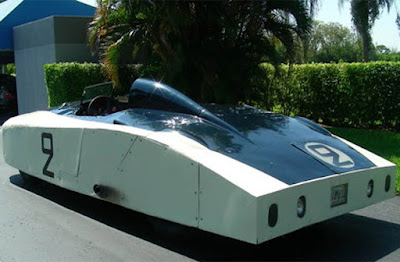PAST SpeedBEAST - In the year 1950, the 24-Hours of Le Mans regulations opened the door for an intriguing chapter in automotive history, allowing standard cars to undergo a fascinating transformation. This era witnessed the birth of one of the most peculiar cars to grace the legendary La Sarthe circuit.
 |
| The Cadillac 'Le Monstre' was one of two Cadillac Coupe DeVille Series 61s prepared by Frick-Tappett Motors for Briggs Cunningham to grace the starting line at the 1950 24-Hours of Le Mans. (Picture from: ConceptCarz) |
Briggs Cunningham, a visionary automotive enthusiast, seized this opportunity by bringing two Frick-Tappett Motors-prepared Cadillac Coupe DeVille Series 61s to the racing scene. The first car retained its original form, standing as a testament to the standard configuration, which the French dubbed Petit Pataud.
 |
| The Cadillac 'Le Monstre' and its sibling Cadillac Coupe DeVille Series 61 'Petit Pataud' in their hey-day run at the 1950 24-Hours of Le Mans. (Picture from: TopGear) |
However, it was the second car that stole the spotlight, boasting a body that defied convention. Crafted from aluminum by Grumman Aircraft Engineering Corporation, the unconventional bodywork aimed to maximize straight-line performance. This design was particularly crucial on the Mulsanne Straight, a 5.95 km stretch of the Le Mans track, accounting for nearly half of the total 13.5 km length. The car not only showcased a unique low and boxy exterior but also demonstrated a superior top speed, reaching 24 km/hour compared to its conventional counterpart.
 |
| The Cadillac 'Le Monstre' crafted from aluminum by Grumman Aircraft Engineering Corporation, the unconventional bodywork aimed to maximize straight-line performance. (Picture from: RevsInstitute) |
Despite its seemingly brick-like exterior, the car's narrow design, refined through extensive wind tunnel testing, contributed to its aerodynamic prowess. Surprisingly, it outpaced its teammate, achieving a remarkable top speed of 130 mph (209.22 kph) – a notable 13 mph (20.92 kph) higher.
 |
| The Cadillac 'Le Monstre' not only showcased a unique low and boxy exterior but also demonstrated a superior top speed, reaching 24 km/hour compared to its conventional counterpart 'Petit Pataud'. (Picture from: SuperRask) |
Dubbed Le Monstre by the French media, the car, driven by Briggs Cunningham and Phil Walter, left a lasting impression. Despite the initial promise shown by Le Monstre, the experiment faced an unfortunate end. The absence of a spade, a cruc ial tool for the race, proved costly as the car became ensnared in a sandbank. Compounded by a gearbox issue, Le Monstre concluded the race in the 11th position, trailing just behind its standard Coupe counterpart driven by Collier brothers, Miles and Sam Collier.
 In the annals of automotive history, the tale of Le Monstre stands as a testament to the audacity of innovation, where a daring vision and unconventional design collided with the challenges of Le Mans, leaving an indelible mark on the racing legacy. Though the experiment may not have reaped the anticipated rewards, the spirit of Le Monstre lives on in the echoes of La Sarthe, reminding us that sometimes, it's the audacious endeavors that etch their names into the vibrant canvas of motorsport history. *** [EKA | FROM VARIOUS SOURCES | ID.MOTORSPORT | REVSINSTITUTE | CONCEPRCARZ | TOPGEAR | SUPERRASK | GOODWOOD ]
In the annals of automotive history, the tale of Le Monstre stands as a testament to the audacity of innovation, where a daring vision and unconventional design collided with the challenges of Le Mans, leaving an indelible mark on the racing legacy. Though the experiment may not have reaped the anticipated rewards, the spirit of Le Monstre lives on in the echoes of La Sarthe, reminding us that sometimes, it's the audacious endeavors that etch their names into the vibrant canvas of motorsport history. *** [EKA | FROM VARIOUS SOURCES | ID.MOTORSPORT | REVSINSTITUTE | CONCEPRCARZ | TOPGEAR | SUPERRASK | GOODWOOD ]Note: This blog can be accessed via your smart phone.


 Logging you in...
Logging you in...